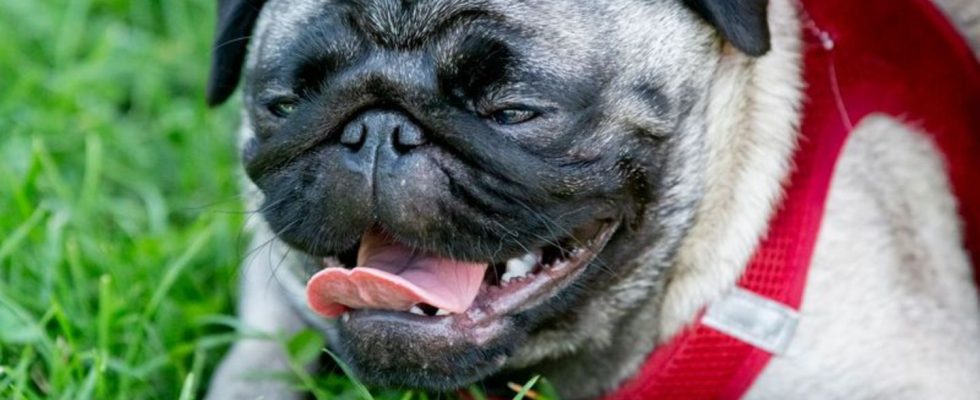Animals
Sick fashion dogs? – Researcher denounces breeding trends
A pug during the 10th International Berlin Pug Meeting in August 2019. Photo
© Christoph Soeder/dpa
Short-nosed pugs with shortness of breath, cancer at a relatively early age: many dogs develop health problems due to their breed. A veterinary pathologist calls them “bruised companions.” What needs to change?
Child substitute, status symbol, accessory for stylish Instagram pictures: Dogs today often play a completely different role for their owners than they did just a few decades ago. For example, mini versions of poodles, Pomeranians or Australian Shepherds that look cute and fit in your handbag are in demand. Extravagant colors are also becoming increasingly popular: Labradors with silver fur, bluish French bulldogs and Chihuahuas.
“These diluted colors look very pretty, but they are not simply variants, but real deformities, serious genetic defects,” says animal pathologist and author Achim Gruber. These animals often suffered from skin diseases and hair loss due to the genetic pigmentation disorder.
Gruber: “Many dog breeds are bred to be totally sick”
The professor at the Institute of Veterinary Medicine at the Free University (FU) Berlin wants to use his book “Schundene Gegenossen” to shed light on the wrong paths in breed breeding and to show solutions. It will be released on October 2nd, two days before World Animal Day. “We have bred many dog breeds that are totally sick,” criticizes the 57-year-old. “There are no races in nature, the concept is man-made.”
Gruber sees two fatal undesirable developments. On the one hand, the scientist criticizes the breeding for unhealthy appearance, such as the shape of the head and snout of pugs, which have difficulty breathing and panting poorly. According to the German Animal Welfare Association, short-headed dogs often struggle with skin, ear and eye problems as well as jaw and tooth misalignments. The majority suffer from shortness of breath, cannot tolerate heat well and have problems sleeping.
“Today we know of well over 80 different illness tendencies, sufferings and sensory disorders that arose as “side effects” of the desired extreme breeding goals,” says Gruber. According to data from a US study of dogs with cancer, purebred animals received this diagnosis at a significantly younger age than mixed breeds (Journal “PLOS ONE”, 2023).
500 to 800 hereditary diseases are known
In addition, according to the animal pathologist, around 500 to 800 hereditary diseases are known to occur in dogs – far more than in all other bred pets. This has to do with inbreeding. One solution, for example, is the so-called retro pug, in which other breeds are crossed so that the animals have a longer nose and fewer health problems. Designer dogs like Labradoodles or Maltipoos could also be a solution because they are mixed breeds.
So-called torture breeding is actually prohibited according to the Animal Protection Act. Gruber criticizes that the law is hardly being implemented. “Many breeders ignore it, and the responsible veterinary authorities mostly look on and do nothing.” Clearly defective breeds continued to fill the waiting rooms of veterinary clinics in large numbers.
The torment of animals
The German Animal Welfare Association is calling for a law that clearly defines what constitutes torture. “What many owners find cute is torture for the animals,” explains association spokeswoman Lea Schmitz. “In order to achieve visual characteristics such as googly eyes, a certain fur pattern or a flat snout in dogs, cats and the like, owners and breeders accept animal suffering.” Not only the breeding, but also the keeping, importing and selling of animals with torture breeding characteristics should be banned – as should advertising with them, she says.
The number of dogs and cats nationwide has increased significantly in recent years. According to the Central Association of Zoological Specialist Companies in Germany (ZZF), there were 10.6 million dogs in 2022. There are also 15.2 million cats.
The illegal puppy trade flourished during the Corona period due to the pet boom, says Lea Schmitz. French bulldogs, Pomeranians and Chihuahuas have recently been the front runners in the illegal animal trade – i.e. breeds that suffer from torturous breeding characteristics. This was the result of an evaluation by the Animal Welfare Association.
“My impression is that many people confuse dogs and cats with branded products such as cars or fashion,” criticizes Gruber. “They expect a new paint job, a smarter shape, color, a new fun factor.” The huge problem is: “The variants in dogs and cats are deformities and genetic disorders that can sometimes be associated with severe suffering and damage.”

